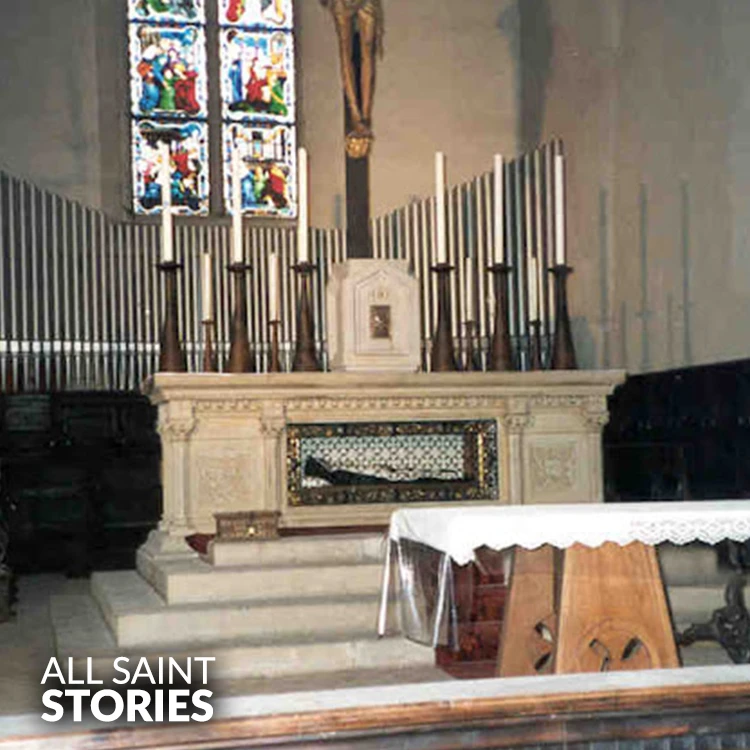Saint Margaret of Castello, beloved servant of God, you lived with great faith, hope, and love despite suffering and hardship. Intercede for us in our times of need, and help us to overcome life's challenges with courage and grace. Guide us to live in humility, and may we find strength in your example. Amen.
ST. MARGARET CASTELLO
ST. MARGARET CASTELLO

St. Margaret of Castello, born in 1287 in Italy, was a blind and deformed child abandoned by her parents due to her physical conditions. Despite her hardships, she led a life of humility, charity, and prayer. She became a Dominican Tertiary and is recognized for her extraordinary faith and devotion. St. Margaret is the patron saint of the disabled and the unwanted, having been canonized in 1696.
St. Margaret of Castello was born in 1287 in Metola, Italy, to a noble family, the Castello family. Her birth was marked by significant challenges, as she was born blind, and it is said that she also had a hunchback and a short stature. Her parents, particularly her father, were ashamed of her and attempted to hide her from the world. Her mother and father were disheartened by her physical condition and even confined her to a small, dark room for much of her early life, away from the rest of the family.
As she grew older, however, St. Margaret began to show signs of extraordinary inner strength. Though born into circumstances that could have easily broken her spirit, she found solace in her faith. She spent much of her childhood in prayer and contemplation, despite the severe isolation imposed on her. Her deep spiritual life began to shine through in her actions, and the grace of God filled her heart with compassion. Eventually, St. Margaret's parents allowed her to leave her confinement, and she began to participate in the religious life.
St. Margaret joined the Dominican Third Order, which was made up of laypeople who followed the spiritual path of the Dominican Order. Her life was marked by a commitment to prayer, penance, and devotion to God. She spent her days helping the poor, sick, and suffering, dedicating herself to serving others. Despite her own physical limitations, St. Margaret never allowed her conditions to hinder her deep love for God and for others. Her compassion for the marginalized, particularly the disabled, was immense. St. Margaret is known to have had the gift of healing and was able to perform miracles, particularly healing those who were ill or disabled.
St. Margaret died in 1320 at the age of 33. Her funeral was attended by many people whose lives had been touched by her humility, kindness, and acts of mercy. Despite the hardships she faced in her early life, St. Margaret’s life was one of great spiritual depth and service to others.
In 1609, St. Margaret was beatified by Pope Paul V. Later, in 1696, Pope Clement X officially canonized her as a saint. Her feast day is celebrated on April 13, a day to reflect on her remarkable life and legacy. St. Margaret of Castello is recognized as the patron saint of the disabled, the unwanted, and the marginalized. Her life serves as an inspiration to those who are suffering, showing them that holiness can be found in even the most difficult of circumstances.
Video Not Found
The information on this website is compiled from various trusted sources. While we aim for accuracy, some details may be incomplete or contain discrepancies.
If you notice any errors or have additional information about this saint, please use the form on the left to share your suggestions. Your input helps us improve and maintain reliable content for everyone.
All submissions are reviewed carefully, and your personal details will remain confidential. Thank you for contributing to the accuracy and value of this resource.
Credits & Acknowledgments
- Anudina Visudhar (Malayalam) – Life of Saints for Everyday
by Msgr. Thomas Moothedan, M.A., D.D. - Saint Companions for Each Day
by A. J. M. Mausolfe & J. K. Mausolfe - US Catholic (Faith in Real Life) – Informational articles
- Wikipedia – General reference content and images
- Anastpaul.com – Saint images and reflections
- Pravachaka Sabdam (Malayalam) – Saint-related content and insights
We sincerely thank these authors and platforms for their valuable contributions. If we have unintentionally missed any attribution, please notify us, and we will make the correction promptly.
If you have any suggestion about ST. MARGARET CASTELLO
Your suggestion will help improve the information about this saint. Your details will not be disclosed anywhere.
© 2025 Copyright @ www.allsaintstories.com






 English
English
 Italian
Italian
 French
French
 Spanish
Spanish
 Malayalam
Malayalam
 Russian
Russian
 Korean
Korean
 Sinhala
Sinhala
 Japanese
Japanese
 Arabic
Arabic
 Portuguese
Portuguese
 Bantu
Bantu
 Greek
Greek
 German
German
 Dutch
Dutch
 Filipino
Filipino